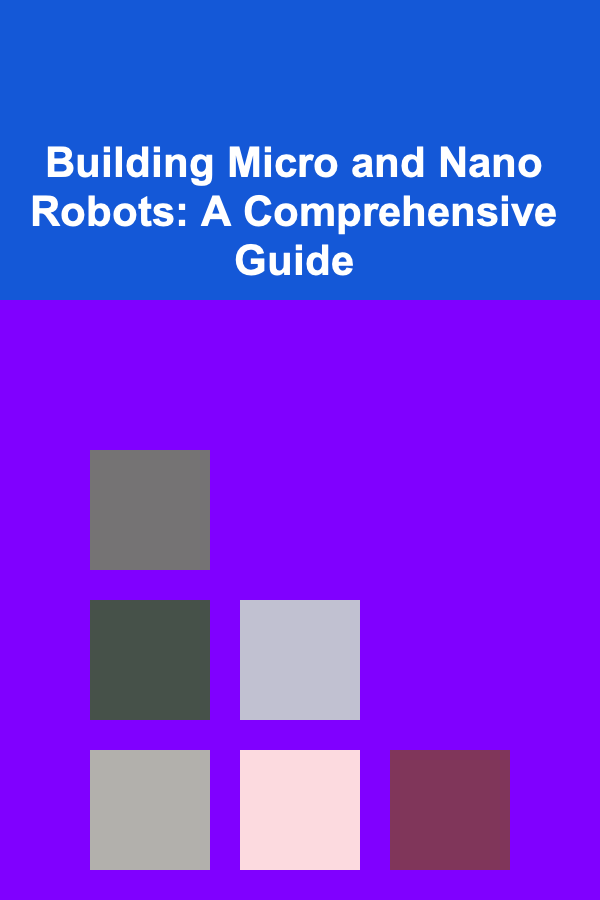
How to Create Word Search Puzzles for Kids with Learning Disabilities
ebook include PDF & Audio bundle (Micro Guide)
$12.99$9.99
Limited Time Offer! Order within the next:
Not available at this time

Creating word search puzzles for kids with learning disabilities can be an engaging, fun, and educational way to support their cognitive development. For children who experience learning challenges, having educational materials tailored to their needs is crucial for building confidence, enhancing learning skills, and making learning an enjoyable experience. Word searches, in particular, are a great way to help children practice important skills such as visual discrimination, reading, vocabulary, and attention to detail, all while having fun.
However, it's essential to understand that not all children with learning disabilities are the same, and different strategies and modifications are necessary to ensure the puzzle is accessible, engaging, and effective. This article will delve into the various aspects of designing word search puzzles that can benefit children with learning disabilities, including tips on choosing appropriate words, adjusting the puzzle difficulty, incorporating visual aids, and fostering an inclusive learning environment.
Understanding Learning Disabilities and Their Impact
Before we dive into the process of creating word search puzzles, it is important to understand what learning disabilities are and how they affect children. Learning disabilities are neurological conditions that affect the way individuals process, retain, and apply information. The most common types of learning disabilities include:
- Dyslexia: Affects reading, spelling, and writing skills, often causing difficulties in decoding words, recognizing letter patterns, and fluently reading text.
- Dyscalculia: Affects mathematical reasoning and number processing, making tasks like recognizing patterns and solving equations more challenging.
- Dysgraphia: Impairs handwriting, fine motor skills, and the ability to organize thoughts into writing.
- Attention Deficit Hyperactivity Disorder (ADHD): Characterized by difficulty with attention regulation, impulse control, and maintaining focus.
- Auditory and Visual Processing Disorders: Challenges in processing sensory input, which can make it difficult for children to interpret sounds and visual cues.
Each child may experience a combination of these challenges, so it's essential to customize educational tools like word search puzzles to their unique needs.
Why Word Search Puzzles Are Beneficial for Kids with Learning Disabilities
Word search puzzles can offer several cognitive and emotional benefits for children with learning disabilities:
- Improving Reading Skills: Word searches help children with dyslexia practice letter recognition, word identification, and vocabulary. They encourage familiarity with word patterns and improve fluency by focusing on recognizing words within a grid.
- Enhancing Visual and Spatial Awareness: Finding words in a grid requires children to use visual discrimination skills, which can benefit those with attention and visual processing challenges.
- Increasing Focus and Attention: Word searches require sustained concentration to locate words, which can be particularly helpful for children with ADHD. These puzzles give them the opportunity to focus on a single task, helping to build patience and concentration.
- Building Vocabulary: As children complete word searches, they encounter new words and reinforce familiar ones. This is an excellent way to expand vocabulary, particularly for children with language processing difficulties.
- Encouraging Motivation: The sense of accomplishment that comes from completing a word search can motivate children to keep trying, which is crucial for kids who may experience frustration with other learning tasks.
Steps to Create Word Search Puzzles for Kids with Learning Disabilities
Creating word search puzzles for kids with learning disabilities requires thoughtful planning and careful consideration. Below are some key steps you can follow to create effective word search puzzles that are both fun and educational.
3.1. Choose Age-Appropriate and Relevant Words
One of the first things to consider when creating a word search puzzle is the selection of words. The words should be:
- Age-appropriate: The difficulty level of the words should match the child's reading ability. For younger children or those just learning to read, use simple words that they can recognize easily. For older children or those with more advanced language skills, you can include more complex words.
- Relevant to the child's learning goals: The words should be aligned with the child's learning objectives. For example, you can create word searches focused on themes such as colors, animals, shapes, numbers, or even specific subject areas like science, geography, or history.
- Contextual and familiar: Using words that are part of the child's everyday environment will make the puzzle more meaningful. For instance, words related to the child's school life or hobbies will likely be more engaging than abstract or unfamiliar words.
3.2. Use Large, Clear Fonts
Children with learning disabilities, especially those with visual processing challenges, can struggle with recognizing words if they are written in small or overly complex fonts. To ensure that the puzzle is accessible, use:
- Larger font sizes: Choose fonts that are large and easy to read. A font size of at least 18 to 24 points is typically ideal for younger children or those with dyslexia.
- Clear, simple fonts: Avoid using fancy or cursive fonts, as they can make letter recognition harder. Sans-serif fonts like Arial or Comic Sans are often more legible.
- Bold letters: Highlight the words in bold to make them stand out and make them easier to spot in the grid.
3.3. Keep the Grid Size Manageable
For children with learning disabilities, especially those with ADHD or concentration issues, large, complex word search grids can be overwhelming and frustrating. To make the puzzle more manageable:
- Use smaller grids: Start with smaller grids (e.g., 5x5 or 6x6) for beginners or younger children. As the child becomes more proficient, you can gradually increase the grid size to challenge them without causing undue stress.
- Avoid clutter: Make sure there is ample white space between words, so the grid doesn't feel crowded. This helps children focus on finding the words and reduces visual confusion.
3.4. Limit the Number of Words
A word search puzzle with too many words can be overwhelming, especially for children with learning disabilities. Limit the number of words in the puzzle to ensure it is both challenging and achievable. For younger children or beginners, 6 to 8 words may be sufficient. For older or more advanced learners, you can increase the word count, but aim to keep it manageable---no more than 15 words in a single puzzle is a good rule of thumb.
3.5. Offer Word Clues or Categories
Providing children with clues or categories can help guide them through the puzzle, making it less frustrating and more educational. Here are a few ways to incorporate clues:
- Clue-based word searches: List the words in the puzzle with a brief description or definition beside each one. This can help children with vocabulary building and reading comprehension.
- Category-based puzzles: Group words into categories such as animals, school supplies, or seasons. This not only helps children with word recognition but also promotes learning about different topics.
3.6. Incorporate Visual Aids
For children with learning disabilities, incorporating visual aids can help reinforce the words in the puzzle. Some ideas include:
- Pictures or illustrations: Add a small image or icon next to each word in the word list. This visual representation helps children associate the word with its meaning and can make the puzzle more engaging.
- Color coding: For children who may struggle with identifying words in a busy grid, you can color-code the word list. For example, highlight all the animal-related words in green, school-related words in blue, and so on.
3.7. Offer Different Puzzle Variations
There are many ways to modify the classic word search puzzle to meet the needs of different children. Experiment with variations to keep the activity fresh and engaging:
- Reversed word search: Instead of finding the words in a grid, you can give the child a list of words and ask them to find these words within a large block of text. This helps children with word identification and context reading.
- Word search with pictures: Create puzzles where children must match the pictures with words. For example, they may need to locate the word "cat" and match it to a picture of a cat.
- Jumbled word search: For a more advanced variation, provide scrambled words in the word list, and the child must unscramble them before searching for them in the grid.
3.8. Provide Rewards and Positive Reinforcement
To keep children motivated, offer rewards and positive reinforcement when they successfully complete the puzzle. This could be verbal praise, stickers, or even a certificate of achievement. Reinforcement helps build confidence and encourages continued engagement with learning activities.
Adapting Word Searches to Specific Learning Disabilities
Different learning disabilities require tailored approaches. Here's how you can adapt word search puzzles for various learning challenges:
4.1. For Kids with Dyslexia
Children with dyslexia often struggle with word decoding, letter reversals, and reading fluency. To support these children:
- Use word lists with simple, frequently-used words.
- Provide extra space between letters to prevent confusion between similar-looking letters (e.g., "b" and "d").
- Avoid using similar-looking letters in the grid to reduce the chances of misidentification.
4.2. For Kids with ADHD
Children with ADHD may have difficulty focusing on tasks for extended periods. To support these children:
- Use shorter, simpler puzzles with fewer words to prevent them from becoming overwhelmed.
- Include fun and colorful designs to keep them engaged.
- Provide the puzzle in smaller, more manageable sections so they can take breaks between solving.
4.3. For Kids with Visual Processing Disorders
For children with visual processing issues, the visual layout of the word search is essential. To help:
- Use large, clear letters and ensure there's enough contrast between the letters and the background.
- Simplify the grid and avoid overcrowding with too many words.
- Include visual cues, such as pictures or colors, to assist with recognition.
Conclusion
Word search puzzles are a valuable tool in helping children with learning disabilities develop essential cognitive skills in a fun and engaging way. By carefully selecting words, designing accessible puzzles, and providing appropriate support, you can create puzzles that enhance reading, visual discrimination, vocabulary, and focus. Tailoring the puzzles to each child's specific needs can make a significant difference in their learning journey, helping them build confidence, expand their knowledge, and improve their cognitive abilities. Ultimately, the key to success is to make learning enjoyable and personalized, allowing each child to thrive at their own pace.

How to Cultivate a Mindful Evening Routine
Read More
How to Get Rid of Mold and Mildew in Your Home
Read More
How to Profit from Your Photography Skills
Read More
How to Cook Mediterranean-Inspired Dishes
Read More
Building Micro and Nano Robots: A Comprehensive Guide
Read More
10 Tips for Planning a Cooperative Gaming Session
Read MoreOther Products

How to Cultivate a Mindful Evening Routine
Read More
How to Get Rid of Mold and Mildew in Your Home
Read More
How to Profit from Your Photography Skills
Read More
How to Cook Mediterranean-Inspired Dishes
Read More
Building Micro and Nano Robots: A Comprehensive Guide
Read More